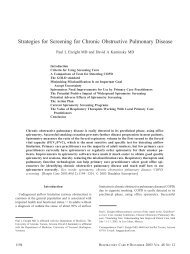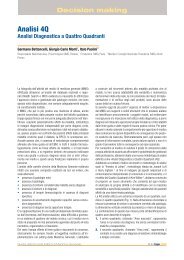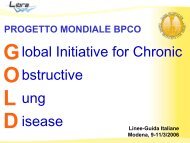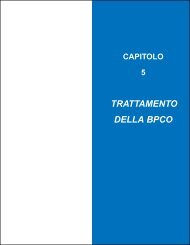COPD phenotypes - GOLD
COPD phenotypes - GOLD
COPD phenotypes - GOLD
You also want an ePaper? Increase the reach of your titles
YUMPU automatically turns print PDFs into web optimized ePapers that Google loves.
Clinical Commentary<br />
Chronic Obstructive Pulmonary Disease Phenotypes<br />
The Future of <strong>COPD</strong><br />
MeiLan K. Han 1 , Alvar Agusti 3 , Peter M. Calverley 4 , Bartolome R. Celli 5 , Gerard Criner 6 , Jeffrey L. Curtis 1,7 ,<br />
Leonardo M. Fabbri 8 , Jonathan G. Goldin 9 , Paul W. Jones 10 , William MacNee 11 , Barry J. Make 12 , Klaus F. Rabe 13 ,<br />
Stephen I. Rennard 14 , Frank C. Sciurba 15 , Edwin K. Silverman 5,16 , Jørgen Vestbo 17 , George R. Washko 5 ,<br />
Emiel F. M. Wouters 18 , and Fernando J. Martinez 2<br />
1 Division of Pulmonary and Critical Care Medicine, University of Michigan Health System, Ann Arbor, Michigan; 2 Thorax Institute, Hospital Clinic,<br />
University of Barcelona, Barcelona, Spain; 3 CIBER Enfermedades Respiratorias, Fundació Caubet-Cimera, Spain; 4 School of Clinical Sciences,<br />
University of Liverpool, Liverpool, United Kingdom; 5 Division of Pulmonary and Critical Care, and 16 Channing Laboratory and Center for Genomic<br />
Medicine, Brigham and Women’s Hospital, Harvard Medical School, Boston, Massachusetts; 6 Division of Pulmonary and Critical Care Medicine,<br />
Temple Lung Center, Temple University School of Medicine; 7 Division of Pulmonary and Critical Care Medicine, Ann Arbor VA Healthsystem, Ann<br />
Arbor, Michigan; 8 Department of Oncology, Haematology and Pulmonary Diseases, University of Modena and Reggio Emilia, Policlinico di Modena,<br />
Modena, Italy; 9 Department of Radiology, David Geffen School of Medicine, University of California Los Angeles, Los Angeles, California; 10 Division<br />
of Clinical Science, St. George’s Hospital Medical School, London, England; 11 ELEGI Colt Research Labs, The Queen’s Medical Research Institute,<br />
University of Edinburgh, Edinburgh, Scotland; 12 Division of Pulmonary and Critical Care, National Jewish Health, University of Colorado Denver<br />
School of Medicine, Denver, Colorado; 13 Department of Pulmonology, Leiden University Medical Center, Leiden, The Netherlands; 14 Division of<br />
Pulmonary and Critical Care, University of Nebraska Medical Center, Omaha, Nebraska; 15 Division of Pulmonary and Critical Care, University of<br />
Pittsburgh Medical Center, Pittsburgh, Pennsylvania; 17 Manchester Academic Health Sciences Centre, University of Manchester, Manchester, United<br />
Kingdom; and 18 Department of Respiratory Medicine, University Hospital Maastricht, Maastricht University, Maastricht, The Netherlands<br />
Significant heterogeneity of clinical presentation and disease progression<br />
exists within chronic obstructive pulmonary disease<br />
(<strong>COPD</strong>). Although FEV 1 inadequately describes this heterogeneity,<br />
a clear alternative has not emerged. The goal of phenotyping is to<br />
identify patient groups with unique prognostic or therapeutic<br />
characteristics, but significant variation and confusion surrounds<br />
use of the term ‘‘phenotype’’ in <strong>COPD</strong>. Phenotype classically refers to<br />
any observable characteristic of an organism, and up until now,<br />
multiple disease characteristics have been termed <strong>COPD</strong> <strong>phenotypes</strong>.<br />
We, however, propose the following variation on this definition:<br />
‘‘a single or combination of disease attributes that describe<br />
differences between individuals with <strong>COPD</strong> as they relate to clinically<br />
meaningful outcomes (symptoms, exacerbations, response to therapy,<br />
rate of disease progression, or death).’’ This more focused<br />
definition allows for classification of patients into distinct prognostic<br />
and therapeutic subgroups for both clinical and research purposes.<br />
Ideally, individuals sharing a unique phenotype would also ultimately<br />
be determined to have a similar underlying biologic or<br />
physiologic mechanism(s) to guide the development of therapy<br />
where possible. It follows that any proposed phenotype, whether<br />
defined by symptoms, radiography, physiology, or cellular or molecular<br />
fingerprint will require an iterative validation process in<br />
which ‘‘candidate’’ <strong>phenotypes</strong> are identified before their relevance<br />
to clinical outcome is determined. Although this schema represents<br />
an ideal construct, we acknowledge any phenotype may be etiologicaxlly<br />
heterogeneous and that any one individual may manifest<br />
multiple <strong>phenotypes</strong>. We have much yet to learn, but establishing<br />
a common language for future research will facilitate our understanding<br />
and management of the complexity implicit to this disease.<br />
Keywords: prognosis; mortality; decline; therapy; outcomes<br />
(Received in original form December 11, 2009; accepted in final form June 2, 2010)<br />
Correspondence and requests for reprints should be addressed to MeiLan K. Han,<br />
M.D., M.S., University of Michigan - Pulmonary and Critical Care, 1500 E. Medical<br />
Center Drive, 3916 Taubman, Ann Arbor, MI 48109. E-mail: mrking@umich.edu<br />
Am J Respir Crit Care Med Vol 182. pp 598–604, 2010<br />
Originally Published in Press as DOI: 10.1164/rccm.200912-1843CC on June 3, 2010<br />
Internet address: www.atsjournals.org<br />
AT A GLANCE COMMENTARY<br />
Scientific Knowledge on the Subject<br />
Significant heterogeneity of clinical presentation and disease<br />
progression exists within chronic obstructive pulmonary<br />
disease (<strong>COPD</strong>). Although FEV 1 inadequately<br />
describes this heterogeneity, a clear alternative has not<br />
emerged.<br />
What This Study Adds to the Field<br />
We propose that <strong>COPD</strong> <strong>phenotypes</strong> should be associated<br />
with clinically meaningful outcomes. This more focused<br />
definition allows for classification of patients into distinct<br />
prognostic and therapeutic subgroups for both clinical and<br />
research purposes. Establishing a common language for<br />
future research will facilitate our understanding and management<br />
of this disease.<br />
The diagnosis, assessment and management of chronic obstructive<br />
pulmonary disease (<strong>COPD</strong>) are currently facing an important<br />
dilemma. On the one hand, <strong>COPD</strong> is defined by the<br />
presence of airflow limitation that is not fully reversible, and<br />
its treatment is mostly guided by the severity of this limitation<br />
(1). On the other hand, it is now widely recognized that <strong>COPD</strong><br />
is a complex syndrome with numerous pulmonary and extrapulmonary<br />
components. Importantly, significant heterogeneity<br />
exists with respect to clinical presentation, physiology, imaging,<br />
response to therapy, decline in lung function, and survival. As<br />
a result, there is consensus that FEV 1 by itself does not<br />
adequately describe the complexity of the disease and that<br />
FEV 1 cannot be used in isolation for the optimal diagnosis,<br />
assessment, and management of the disease. However, a clear<br />
alternative has not yet been defined. Considering that almost all<br />
we currently know about pathophysiology, mechanism, and<br />
response to treatment is regarding <strong>COPD</strong> caused by or associ-
Clinical Commentary 599<br />
ated with cigarette smoking, the discussion that follows relates<br />
only to <strong>COPD</strong> observed in smokers.<br />
The identification and subsequent grouping of key elements<br />
of the <strong>COPD</strong> syndrome into clinically meaningful and useful<br />
subgroups (<strong>phenotypes</strong>) that can guide therapy more effectively<br />
is a potential solution to this dilemma. Caution, however, is<br />
warranted when clustering patients with similar symptoms and<br />
clinical manifestations, as phenotyping in <strong>COPD</strong> is still a relatively<br />
young endeavor as compared with other fields. The<br />
novelty of <strong>COPD</strong> phenotyping is illustrated by the fact that<br />
a MEDLINE search revealed just over 400 phenotyping papers<br />
published in the field of <strong>COPD</strong>, whereas, for instance, it<br />
identifies more than 5,000 in breast cancer. Moreover, there is<br />
significant variation, confusion, and uncertainty surrounding use<br />
of the term phenotype in <strong>COPD</strong>. A common language for<br />
future research should facilitate our understanding of the<br />
heterogeneity implicit to this disease and help us design better<br />
alternatives for the prevention and management of the disease.<br />
This article discusses and refines the concept of phenotyping in<br />
<strong>COPD</strong> and presents a possible schema that can serve as<br />
a framework for future research.<br />
<strong>COPD</strong> PHENOTYPES: AN OPERATIONAL DEFINITION<br />
The classic definition of a phenotype reflects the observable<br />
structural and functional characteristics of an organism determined<br />
by its genotype and modulated by its environment:<br />
the interactions between ‘‘nature’’ and ‘‘nurture’’ (2). Although<br />
this definition has been historically useful in a variety of<br />
contexts (3), in medicine in general, and in <strong>COPD</strong> in particular,<br />
we believe this concept must be refined to more efficiently fulfill<br />
the following clinical and research goals. From a clinical and<br />
patient-centered perspective, a <strong>COPD</strong> phenotype should be<br />
able to classify patients into distinct subgroups that provide<br />
prognostic information and allow us to better determine<br />
appropriate therapy that alters clinically meaningful outcomes.<br />
From a research standpoint, phenotyping should allow us to<br />
select a uniform group of patients and assess the most important<br />
outcome measures in that group for therapeutic clinical trials.<br />
Phenotypes can also form the basis for biological mechanistic<br />
investigations. Hence the ultimate goal of phenotyping in<br />
medicine is to allow the identification of patient groups with<br />
unique prognostic or therapeutic characteristics. In <strong>COPD</strong> until<br />
now, disease characteristics and/or disease severity have frequently<br />
been termed <strong>COPD</strong> <strong>phenotypes</strong> (3).<br />
Accordingly, we propose the following variation on the<br />
traditional definition of a phenotype: ‘‘a single or combination<br />
of disease attributes that describe differences between individuals<br />
with <strong>COPD</strong> as they relate to clinically meaningful outcomes<br />
(symptoms, exacerbations, response to therapy, rate of<br />
disease progression, or death).’’ In other words, it is proposed<br />
that <strong>phenotypes</strong> in <strong>COPD</strong> should have real predictive value. It<br />
follows, therefore, that any proposed phenotype must be prospectively<br />
validated and refined for each of the outcomes to<br />
which it relates. Identifying the outcome is important as certain<br />
attributes, such as dyspnea, depression, or exacerbations, could<br />
be viewed as outcomes or <strong>phenotypes</strong> depending on the clinical<br />
context.<br />
Ideally, individuals clustering within a unique phenotype and<br />
exhibiting similar clinical outcomes should also exhibit a similar<br />
therapeutic response profile because of a similar underlying<br />
biologic or physiologic mechanism. At this point in time,<br />
however, the field of <strong>COPD</strong> phenotyping has not yet reached<br />
the stage at which we have significant understanding regarding<br />
the mechanism(s) behind every clinical presentation. We therefore<br />
believe that at this juncture, the proposed approach<br />
represents the best way forward. Ideally, by identifying patient<br />
subgroups that have unique characteristics as they relate to<br />
clinically meaningful outcomes, we may ultimately discover the<br />
etiologic mechanisms. However, it should also be pointed out<br />
that an understanding of mechanism is not necessarily required<br />
to significantly benefit patients and that the process of phenotype<br />
validation is an iterative one. As an example from the field<br />
of cardiology, the clinical effects of HMG-CoA reductase<br />
inhibitors (statins) were initially believed to be due largely to<br />
their cholesterol-lowering effect. Clinical trials, however,<br />
revealed benefit beyond what might be expected from changes<br />
in lipid levels alone, suggesting that statins likely have pleiotropic<br />
effects. This has led to further clinical trials, and the<br />
subgroup of patients who might benefit from statins has<br />
expanded from those with elevated cholesterol to those with<br />
elevated CRP. In <strong>COPD</strong>, the National Emphysema Treatment<br />
Trial identified a subgroup of patients with upper lobe–predominant<br />
emphysema and low exercise capacity who benefit<br />
from lung volume reduction surgery (LVRS), although a mechanistic<br />
explanation for benefit in this specific subgroup is not<br />
readily obvious. Such examples indicate how similar clinical<br />
response can identify <strong>phenotypes</strong> with immediate and direct<br />
implications for patients in the absence of a well-defined<br />
mechanism.<br />
It should be noted, however, that not all outcomes may be<br />
modifiable by (current) therapy, and that some outcomes may<br />
arise from multiple etiologic mechanisms. Furthermore, response<br />
to therapies can also be difficult to measure reliably<br />
and many of the treatments and measures we typically use (for<br />
example, FEV 1 ) may not be specific, well targeted, or sensitive<br />
enough to uniquely identify a phenotypic subgroup.<br />
POTENTIAL PHENOTYPES<br />
Here we discuss how disease attributes fit within the phenotyping<br />
framework we have proposed. As patient outcomes are<br />
a key component of the operational definition of phenotype<br />
proposed above, potential <strong>phenotypes</strong> are discussed within the<br />
clinical outcomes to which they relate.<br />
Clinical Manifestations<br />
Age, smoking history, sex, and ethnicity may all significantly<br />
impact disease presentation and progression. For example, lung<br />
function declines with increasing age (4). Female sex appears to<br />
be associated with worse quality of life (QOL) and higher rates<br />
of depression and anxiety; data suggest female sex may also be<br />
associated with higher susceptibility to the toxic effects of<br />
smoking (5). Women may also differ from men in the extent<br />
and distribution of airway abnormality and emphysema (5),<br />
which in themselves are not clinically relevant outcomes, but<br />
may relate to clinically relevant outcomes (see Radiologic<br />
Characterization section below). Body composition and dyspnea<br />
can be assessed with various instruments, and both descriptors<br />
appear to have independent prognostic value either as<br />
sole measures or as components of the body mass index (BMI),<br />
airflow obstruction, dyspnea, and exercise capacity (BODE)<br />
Index (6). Similarly, depression and anxiety have been independently<br />
associated with an increased frequency of hospital<br />
admissions and <strong>COPD</strong> exacerbation relapses (7, 8).<br />
Physiological Manifestations<br />
Spirometric indices, including FEV 1 , FVC, and their ratio, are<br />
used to define the presence and severity of disease. Unfortunately,<br />
these features explain less than 10 to 25% of the disease<br />
impact on patient symptoms, QOL, and exercise performance<br />
(9–11). Rapid physiologic progression as indicated by change in
600 AMERICAN JOURNAL OF RESPIRATORY AND CRITICAL CARE MEDICINE VOL 182 2010<br />
FEV 1 , however, may indicate a distinct phenotype. Rapid<br />
decline in FEV 1 is not only predictive of morbidity, mortality,<br />
and hospitalization rates (12) but has also been linked to distinct<br />
plasma biomarker signatures (13). Bronchodilator reversibility<br />
and airway hyperresponsiveness are highly variable in patients<br />
with <strong>COPD</strong> from patient to patient, and also within a given<br />
patient when measured serially over time, and thus have limited<br />
sensitivity or specificity in distinguishing <strong>COPD</strong> from asthma<br />
(14, 15). Airway hyperresponsiveness has been associated with<br />
a greater longitudinal decline in lung function; bronchodilator<br />
reversibility defined as change in FEV 1 may be less common<br />
with an emphysema-dominant phenotype (14, 16). Hyperinflation<br />
may also define patient groups associated with varying<br />
mortality or functional impairment (17, 18). Similarly, diffusing<br />
capacity impairment is an independent predictor of the magnitude<br />
of radiologic emphysema (19), presence of resting hypoxemia,<br />
exercise-induced arterial oxygen desaturation (20), and<br />
functional impairment (21). Although we cannot say with<br />
certainty, this may reflect unique biologic processes (22). Other<br />
physiologic measures, such as hypercapnia, physiologic exercise<br />
impairment, or even measures of physical activity derived from<br />
actigraphy, may also reflect unique biological processes and<br />
consequently potential opportunities for unique therapeutic<br />
interventions (23, 24).<br />
Radiologic Characterization<br />
Quantitative assessment of emphysema by computed tomography<br />
(CT) scanning offers an objective measure of parenchymal<br />
disease that correlates well with histopathologic findings and is<br />
predictive of the degree of expiratory airflow obstruction (25).<br />
Objective measures of proximal airway wall thickening<br />
obtained via CT are inversely correlated with lung function<br />
and relate to a subject’s burden of small airway disease (26) and<br />
exacerbation frequency (27). More recent work suggests that<br />
the correlative strength between CT measures of airway wall<br />
thickening and lung function increase when examining more<br />
distal fourth- and fifth-generation airways (28), although such<br />
structures approach the limits of accurate measurement using<br />
most currently available CT imaging reconstruction protocols<br />
and should therefore be used with caution.<br />
Whether or not the presence of specific lung structural<br />
abnormalities (including emphysema, airway wall thickening,<br />
and/or bronchiectasis) predict meaningful clinical outcome is<br />
an area of current research interest (29, 30). Increasing<br />
emphysema severity as defined by CT has been associated<br />
with worse health status (27) and increased mortality (31). The<br />
National Emphysema Treatment Trial provides the most<br />
compelling evidence supporting distinct CT-based <strong>phenotypes</strong><br />
in defining an increased risk of mortality in patients with<br />
homogenous emphysema and impaired FEV 1 or diffusing<br />
capacity of carbon monoxide undergoing LVRS, whereas<br />
upper lobe–predominant emphysema and a low postrehabilitation<br />
exercise capacity identify a group of emphysema<br />
patients who experience a mortality and functional benefit<br />
from LVRS (16). These compelling data strongly support that<br />
a combination of CT imaging and physiological testing can<br />
clearly impact therapeutic decision making, thus validating its<br />
value as a phenotype according to our operational definition.<br />
<strong>COPD</strong> Exacerbations<br />
Within the framework we have proposed, an acute exacerbation<br />
of <strong>COPD</strong> (AE<strong>COPD</strong>) could be viewed as outcome or, in the<br />
context of describing a ‘‘frequent exacerbator,’’ a phenotype.<br />
AE<strong>COPD</strong> is currently defined as: ‘‘A sustained worsening of<br />
the patient’s condition, from the stable state and beyond normal<br />
day-to-day variations, that is acute in onset and necessitates<br />
a change in regular medication in a patient with underlying<br />
<strong>COPD</strong>’’ (32). This general description poses numerous operational<br />
challenges for use in clinical phenotyping. It remains<br />
unclear if these changes are quantitative or if there is also<br />
a qualitative element. Similarly, the normal variation in symptoms<br />
in patients with <strong>COPD</strong> remains relatively unexplored; how<br />
long changes in symptoms must be sustained before being<br />
characterized as an exacerbation varies according to study.<br />
Sputum color is a marker of bacterial-infective exacerbations<br />
that has validity in populations of patients (33). Although the<br />
consensus definition states: ‘‘necessitates a change in regular<br />
medication,’’ the criteria invoked by health-care providers to<br />
judge when to alter medication remains unclear. Importantly,<br />
patient-recorded increases in symptoms that appear to be<br />
exacerbations outnumber those that cause them to present for<br />
medical attention (34). In addition, events with worsening<br />
symptoms that do not lead patients to seek additional care<br />
may, nevertheless, impact prognosis.<br />
Despite limitations in defining AE<strong>COPD</strong>s, numerous investigators<br />
have highlighted the negative implications of these<br />
events in patients with <strong>COPD</strong>. Reviews of the published data<br />
confirm that AE<strong>COPD</strong>s exert significant short- and long-term<br />
negative effects on health-related QOL in patients with <strong>COPD</strong><br />
(35). AE<strong>COPD</strong> episodes also result in modest, yet measurable,<br />
acute effects on pulmonary function (36). Perhaps most importantly,<br />
repeated AE<strong>COPD</strong>s have also been suggested to result<br />
in negative effects on longitudinal lung function (37) and can be<br />
identified by previous history of AE<strong>COPD</strong> (38), suggesting that<br />
patients with <strong>COPD</strong> with recurrent AE<strong>COPD</strong>s may reflect<br />
a distinct phenotypic group. This subgroup may be particularly<br />
relevant in consideration as a phenotype because it appears to<br />
be responsive to therapy with inhaled bronchodilators either<br />
alone or in combination with inhaled corticosteroids (39).<br />
Furthermore, a chronic bronchitic subgroup with sputum production<br />
and prior exacerbation history has recently identified<br />
a <strong>COPD</strong> cohort who experience improvement with the novel<br />
phosphodiesterase 4 inhibitor roflumilast (40). Here we have an<br />
example of targeting a drug for a specific <strong>COPD</strong> subpopulation<br />
that was identified by post hoc analysis of prospectively<br />
collected data from well-conducted clinical trials. This methodology<br />
may have value when considering variables not defined by<br />
therapeutic responses and is analogous to the widely adopted<br />
approach of identifying and then confirming genotypic information<br />
in replicate data sets. Post hoc analysis of well-done,<br />
prospective, placebo-controlled clinical trials conducted in<br />
patients with <strong>COPD</strong> with a range of disease severity and<br />
symptoms may be a fertile area in which to conduct responder<br />
analyses. This method of retrospective analysis may help to<br />
uncover patient attributes that indicate differential responses to<br />
treatment and may lead to the discovery of separate <strong>COPD</strong><br />
clinical <strong>phenotypes</strong> potentially linked with molecular fingerprints<br />
of disease pathogenesis.<br />
Systemic Inflammation<br />
The presence of systemic inflammation may represent a unique<br />
<strong>COPD</strong> phenotype.<br />
If defined by the presence of elevated biomarkers (including<br />
C-reactive protein, serum amyloid A, proinflammatory cytokines<br />
IL-6 and IL-8, tumor necrosis factor a, and leukocytes),<br />
systemic inflammation does not appear to be present in every<br />
patient with <strong>COPD</strong> (41, 42). In fact, the prevalence of systemic<br />
inflammation in <strong>COPD</strong> appears to vary significantly depending<br />
on the particular marker (or combination of markers) chosen.<br />
Evidence of systemic inflammation can also be detected in
Clinical Commentary 601<br />
patients who appear otherwise clinically stable (41, 42) but with<br />
evidence of further increase during exacerbations (43). Additionally,<br />
the presence of systemic inflammation does not appear<br />
to be unique to <strong>COPD</strong> but also occurs in other chronic diseases<br />
and even during normal aging. As it relates to phenotyping, thus<br />
far no clear relationship between systemic inflammation and<br />
a particular aspect of <strong>COPD</strong> (such as the severity of airflow<br />
limitation or the presence of emphysema, airway colonization,<br />
arterial hypoxemia, comorbidities, or symptoms), has clearly<br />
emerged. Thus, at this point in time it is unclear what mechanisms<br />
drive the presence, type, and/or severity of systemic<br />
inflammation in any given patient. It is also unclear whether<br />
therapy aimed at optimizing pulmonary function in <strong>COPD</strong><br />
results in a reduction of systemic inflammation in these patients<br />
(44, 45) or whether the direct targeting of systemic inflammation<br />
influences the natural history of <strong>COPD</strong>.<br />
Comorbidities<br />
Patients with <strong>COPD</strong> often present with comorbid diseases,<br />
including cardiovascular disease, metabolic syndrome, osteoporosis,<br />
depression, and skeletal muscle wasting and dysfunction<br />
(46, 47). Systemic inflammation may contribute to the development<br />
of comorbid conditions and these disorders can be seen as<br />
manifestations of <strong>COPD</strong> or vice versa (48). Accelerated aging is<br />
a further process that could account for both the local lung<br />
effects of <strong>COPD</strong> and its comorbidities (49). Aging is characterized<br />
by a progressive, generalized impairment of function and<br />
amplification of the inflammatory response (50) that results in<br />
an increased vulnerability to environmental challenge and an<br />
increased risk of disease. The presence of many of these<br />
comorbidities appears to have a deleterious effect on several<br />
outcomes in <strong>COPD</strong> (51). In particular, diabetes, hypertension,<br />
cardiovascular disease, and cancer increase the risk of death in<br />
<strong>COPD</strong> (51). However, whether treatment of comorbid conditions<br />
alters the natural history of <strong>COPD</strong> or whether treatment<br />
of <strong>COPD</strong> is altered by the presence of a concomitant comorbidity<br />
awaits further study.<br />
MULTIDIMENSIONAL INDICES<br />
Recently several multidimensional indices have been described<br />
for prognostic purposes in <strong>COPD</strong>. Perhaps best well known of<br />
these is the BODE Index to predict mortality, which incorporates<br />
dyspnea, BMI, FEV 1 , and exercise capacity as measured<br />
by 6-minute walk distance (6MWD). Modifications of the<br />
BODE index have also been described, including the mBODE<br />
(replaces 6MWD with _ VO 2 ) (52), e-BODE (BODE plus exacerbations)<br />
(53), and BODE-x (substitution of exacerbations for<br />
exercise capacity) (53), as well as the ADO index (dyspnea,<br />
FEV 1 , and age), which are all better predictors of mortality in<br />
<strong>COPD</strong> than FEV 1 alone (6, 54). Other indices that have been<br />
described include the <strong>COPD</strong> Prognostic Index (QOL, FEV 1 ,<br />
age, sex, BMI, exacerbation history, cardiovascular disease<br />
history) (55) that predicts mortality, hospitalization, and exacerbation<br />
frequency, the SAFE Index (QOL, FEV 1 , 6MWD)<br />
(56) to predict exacerbation frequency, and the DOSE Index<br />
(dyspnea, smoking status, FEV 1 , and prior exacerbation history),<br />
which also predicts exacerbations (57). From the standpoint<br />
of clinical phenotyping, such multidimensional indices are<br />
useful in their ability to group patients in terms of clinically<br />
relevant outcomes. However, from a research standpoint, a note<br />
of caution is warranted. Although it is possible that the<br />
seemingly diverse measures included in a multidimensional<br />
index actually relate to a shared latent variable responsible<br />
for the clinical presentation, it is also possible that by grouping<br />
patients in this fashion we may be blurring distinct features of<br />
the disease that may hamper our understanding of the biologic<br />
or physiologic basis for the shared outcome.<br />
WHERE DO WE GO FROM HERE?<br />
The identification of <strong>COPD</strong> <strong>phenotypes</strong> will require an iterative<br />
validation process in which candidate <strong>phenotypes</strong> are identified<br />
before their relevance to clinical outcome is determined (Figure<br />
1). As research is currently advancing on all fronts simultaneously,<br />
there are multiple points of entry into this process of<br />
phenotype identification (see Figure 1). Borrowing from the<br />
field of breast cancer, initially hormone-based therapies were<br />
tested in the general breast cancer population, but it was<br />
ultimately determined that that the presence of estrogen and<br />
progesterone receptors within the tumor determined the response<br />
to therapy (58). In asthma, cellular <strong>phenotypes</strong> of<br />
asthma (eosinophilic, neutrophilic, and paucigranulocytic) were<br />
identified by analyses of sputum and subsequently used to direct<br />
the successful application of mepolizumab (anti–IL-5) therapy<br />
(59). In <strong>COPD</strong>, roflumilast was initially studied in a general<br />
<strong>COPD</strong> population, but it was ultimately determined that it is<br />
a subpopulation of patients (FEV 1 , 50% predicted, chronic<br />
cough, and sputum production) who demonstrate the greatest<br />
clinical response. Mechanistic studies, however, will be needed<br />
to understand the biologic basis for response in this subgroup.<br />
From a practical standpoint, validation of <strong>phenotypes</strong> in<br />
<strong>COPD</strong> will require longitudinal data collection in carefully<br />
characterized patient populations. Studies such as Evaluation<br />
Figure 1. Ideal phenotyping construct wherein candidate<br />
<strong>phenotypes</strong> are validated once their relevance to clinical<br />
outcomes is established. There are multiple potential<br />
points of entry into this iterative process of phenotype<br />
identification. For instance, similar clinical outcomes may<br />
define a subpopulation that leads to the identification of<br />
a biologic target and focused therapy. Alternatively, the<br />
process might begin with the differentiation of subgroups<br />
based on a biologic marker that is then validated by<br />
similar clinical response within subgroups.
602 AMERICAN JOURNAL OF RESPIRATORY AND CRITICAL CARE MEDICINE VOL 182 2010<br />
of <strong>COPD</strong> Longitudinally to Identify Predictive Surrogate<br />
Endpoints (ECLIPSE), Subpopulations and intermediate outcome<br />
measures in <strong>COPD</strong> (SPIROMICS), and <strong>COPD</strong>Gene that<br />
are systematically gathering clinical, physiologic, radiologic,<br />
biologic, and genetic data on <strong>COPD</strong> subjects will aid in this<br />
regard. Additionally, advanced statistical techniques may also<br />
prove useful in identifying candidate phenotypic subgroups.<br />
One such example is cluster analysis, which has a basis both in<br />
mathematics and biology and is a technique for data exploration.<br />
Cluster analysis encompasses a number of different<br />
algorithms for grouping subjects without an a priori hypothesis.<br />
A related statistical technique, factor analysis, may also prove<br />
useful in <strong>COPD</strong> phenotyping. Although the goal of cluster<br />
analysis is to reduce the number of observations or cases by<br />
grouping them into a smaller set of clusters, the goal of factor<br />
analysis is to reduce the number of variables by grouping them<br />
into a smaller set of factors. Cluster and factor analysis have<br />
been used in conjunction in <strong>COPD</strong> to identify key variables on<br />
which to select clusters of related patients (60–63). These types<br />
of analyses would still, however, require longitudinal validation<br />
to determine how such clustered subjects differ with respect to<br />
important clinical outcomes. In addition, such analyses may or<br />
may not ultimately be useful in defining specific biologic<br />
pathways or therapies.<br />
The suggested schema for phenotype identification, however,<br />
represents an ideal construct, as almost every outcome measure<br />
other than death displays inherent difficulties with measurement.<br />
Furthermore, for every phenotype, a specific therapy may<br />
not be ultimately identified. An individual’s phenotype may not<br />
be readily apparent at an early stage of disease. It may also be<br />
that any one individual has the potential to express a range of<br />
<strong>phenotypes</strong> that are ultimately determined by the individual’s<br />
unique biology and exposures. Finally, it should be recognized<br />
that most cellular functions (and their perturbations in disease<br />
states) are performed by a complex network of genes, proteins,<br />
and metabolites that interact through biochemical and physical<br />
interactions. The new field of systems biology has begun to<br />
relate these ‘‘omic’’ networks to disease networks (comorbidities)<br />
and even social networks (smoking, obesity). Consequently,<br />
the concept of a ‘‘diseasome,’’ linking cellular networks<br />
and phenotypic manifestations, is beginning to emerge. Such<br />
research strategies may also prove valuable in identifying<br />
relevant and novel <strong>phenotypes</strong> in <strong>COPD</strong>.<br />
Author Disclosure: M.K.H. received up to $1,000 from Novartis in consultancy<br />
fees, $1,001–$5,000 from CSL Behring in advisory board fees, $5,001–$10,000<br />
from GlaxoSmithKline in lecture fees, and up to $1,000 from UpToDate in<br />
royalties. A.A. received $5,001–$10,000 from GlaxoSmithKline, $5,001–$10,000<br />
from Almirall, and $5,001–$10,000 from Nycomed in advisory board fees;<br />
$5,001–$10,000 from GlaxoSmithKline, $5,001–$10,000 from AstraZeneca,<br />
and $5,001–$10,000 from Almirall in lecture fees; and more than $100,001<br />
from GlaxoSmithKline, $10,001–$50,000 from Pfizer, $5,001–$10,000 from<br />
Boehringer Ingelheim, and more than $100,001 from Almirall in industrysponsored<br />
grants. P.M.C. received $5,001–$10,000 from Pfizer, $1,001–<br />
$5,000 from AstraZeneca, and $5,001–$10,000 from Chiesi in consultancy fees;<br />
$5,001–$10,000 from GlaxoSmithKline in advisory board fees; $1,001–$5,000<br />
from Altana and $10,001–$50,000 from GlaxoSmithKline in lecture fees; and<br />
$10,001–$50,000 from Nycomed, $50,001–$100,000 from GlaxoSmithKline,<br />
and $10,001–$50,000 from Boehringer Ingelheim in industry-sponsored grants.<br />
B.R.C. does not have a financial relationship with a commercial entity that has an<br />
interest in the subject of this manuscript. G.C. received $1,001–$5,000 from<br />
Boehringer Ingelheim, $1,001–$5,000 from GlaxoSmithKline, and $1,001–<br />
$5,000 from Aeris in industry-sponsored grants for a research study. J.L.C.<br />
received $1,001–$5,000 from AstraZeneca in honorarium for a nonpromotional<br />
lecture (November 2007), and $10,001–$50,000 from Boehringer Ingelheim in<br />
industry-sponsored grants (BI Protocol 205.325, which ended September 30,<br />
2008). L.M.F. received $10,001–$50,000 from Nycomed, $10,001–$50,000<br />
from GlaxoSmithKline, $10,001–$50,000 from Merck Sharpe & Dohme,<br />
$10,001–$50,000 from Sigma-Tau, $10,001–$50,000 from AstraZeneca,<br />
$50,001–$100,000 from Boehringer Ingelheim, and $50,001–$100,000 from<br />
Chiesi Farmaceutici in consultancy fees; $1,001–$5,000 from Nycomed, $1,001–<br />
$5,000 from AstraZeneca, $1,001–$5,000 from Abbott, $1,001–$5,000 from<br />
Boehringer Ingelheim, $1,001–$5,000 from Chiesi Farmaceutici, $1,001–$5,000<br />
from GlaxoSmithKline, $1,001–$5,000 from Merck Sharp & Dohme, $1,001–<br />
$5,000 from Novartis, $1,001–$5,000 from UCB, $1,001–$5,000 from Roche,<br />
and $1,001–$5,000 from Pfizer in advisory board fees; $1,001–$5,000 from<br />
AstraZeneca, $1,001–$5,000 from Abbott, $1,001–$5,000 from Boehringer<br />
Ingelheim, $1,001–$5,000 from Chiesi Farmaceutici, $1,001–$5,000 from<br />
GlaxoSmithKline, $1,001–$5,000 from Merck Sharp & Dohme, $1,001–$5,000<br />
from Novartis, $1,001–$5,000 from Sigma-Tau, $1,001–$5,000 from UCB,<br />
$1,001–$5,000 from Roche, and $1,001–$5,000 from Pfizer in lecture fees.<br />
L.M.F.’s dependent received $50,001–$100,000 from Nycomed, $50,001–<br />
$100,000 from Abbott, $50,001–$100,000 from AstraZeneca, $50,001–<br />
$100,000 from Boehringer Ingelheim, $50,001–$100,000 from Menarini,<br />
$50,001–$100,000 from Schering Plough, $50,001–$100,000 from Chiesi<br />
Farmaceutici, $50,001–$100,000 from Sigma-Tau, $50,001–$100,000<br />
from Novartis, $50,001–$100,000 from GlaxoSmithKline, $50,001–$100,000<br />
from Merck Sharp & Dohme, $50,001–$100,000 from UCB, and $50,001–<br />
$100,000 from Pfizer in industry-sponsored grants. J.G.G. received more than<br />
$100,001 from MedQIA in an industry-sponsored grant. P.W.J. received $5,001–<br />
$10,000 from GlaxoSmithKline, $1,001–$5,000 from Almirall, $5,001–$10,000<br />
Spiration, and $5,001–$10,000 from Novartis in consultancy fees; $5,001–<br />
$10,000 from GlaxoSmithKline, $5,001–$10,000 from Almirall, $1,001–$5,000<br />
from AstraZeneca, $1,001–$5,000 from Roche, and $5,001–$10,000 from<br />
Spiration in advisory board fees; and $10,001–$50,000 from GlaxoSmithKline<br />
and $1,001–$5,000 from AstraZeneca in lecture fees. W.M. received $1,001–<br />
$5,000 from Pfizer Pharmaceuticals in consultancy fees, $1,001–$5,000 from<br />
GlaxoSmithKline and $1,001–$5,000 from Pfizer in advisory board fees, $5,001–<br />
$10,000 from GlaxoSmithKline and $5,001–$10,000 from AstraZeneca in lecture<br />
fees, and more than $100,001 from GlaxoSmithKline and more than $100,001<br />
from Pfizer in industry-sponsored grants. B.J.M. does not have a financial<br />
relationship with a commercial entity that has an interest in the subject of this<br />
manuscript. K.F.R. received $10,001–$50,000 from Nycomed and $5,001–<br />
$10,000 from Forest in consultancy fees; $5,001–$10,000 from AstraZeneca,<br />
$5,001–$10,000 from Boehringer Ingelheim, $5,001–$10,000 from Chiesi,<br />
$5,001–$10,000 from Novartis, and $1,001–$5,000 from Pearl in advisory board<br />
fees; $1,001–$5,000 from Merck Sharpe and Dohme, $1,001–$5,000 from<br />
GlaxoSmithKline, $1,001–$5,000 from Chiesi, and $1,001–$5,000 from Boehringer<br />
Ingelheim in lecture fees; and $5,001–$10,000 from Nycomed and<br />
$5,001–$10,000 from Forest for serving as an expert witness. K.F.R.’s dependent<br />
received more than $100,001 from Chiesi, $50,001–$100,000 from AstraZeneca,<br />
more than $100,001 from Boehringer Ingelheim, and $10,001–$50,000<br />
from Novartis in industry-sponsored grants. S.I.R. received $1,001–$5,000 from<br />
Able Associates, up to $1,000 from Adelphi Research, $10,001–$50,000 from<br />
Almirall/Prescott, $1,001–$5,000 from APT Pharma/Britnall, $1,001–$5,000<br />
from Aradigm, $1,001–$5,000 from AstraZeneca, $5,001–$10,000 from Boehringer<br />
Ingelheim, up to $1,000 from Chiesi, up to $1,000 from Common Health,<br />
up to $1,000 from Consult Complete, $1,001–$5,000 from <strong>COPD</strong>Forum, up to<br />
$1,000 from Data Monitor, up to $1,000 from Decision Resources, up to $1,000<br />
from Defined Health, $1,001–$5,000 from Dey, up to $1,000 from Dunn Group,<br />
up to $1,000 from Eaton Associates, up to $1,000 from Equinox, up to $1,000<br />
from Gerson, $10,001–$50,000 from GlaxoSmithKline, up to $1,000 from<br />
Infomed, up to $1,000 from KOL Connection, up to $1,000 from M. Pankove,<br />
up to $1,000 from MedaCorp, up to $1,000 from MDRx Financial, up to $1,000<br />
from Mpex, $10,001–$50,000 from Novartis, $10,001–$50,000 from Nycomed,<br />
$1,001–$5,000 from Oriel Therapeutics, $1,001–$5,000 from Otsuka, up to<br />
$1,000 from Pennside Partners, $5,001–$10,000 from Pfizer (Varenicline), up to<br />
$1,000 from PharmaVentures, $1,001–$5,000 from Pharmaxis, up to $1,000<br />
from Price Waterhouse, up to $1,000 from Propagate, up to $1,000 from<br />
Pulmatrix, up to $1,000 from Reckner Associates, up to $1,000 from Recruiting<br />
Resources, $1,001–$5,000 from Roche, up to $1,000 from Schlesinger Medical,<br />
up to $1,000 from Scimed, up to $1,000 from Sudler and Hennessey, $1,001–<br />
$5,000 from TargeGen, $1,001–$5,000 from Theravance, $1,001–$5,000 from<br />
UBS, $1,001–$5,000 from Uptake Medical, and $5,001–$10,000 from Vantage<br />
Point Mgmt in consultancy advisory board fees; $10,001–$50,000 from Astra-<br />
Zeneca, $5,001–$10,000 from Boehringer Ingelheim, $10,001–$50,000 from<br />
Creative Educational Concept, $5,001–$10,000 from the France Foundation,<br />
$1,001–$5,000 from Information TV, $1,001–$5,000 from the Network for<br />
Continuing Ed, $10,001–$50,000 from Novartis, $1,001–$5,000 from Pfizer,<br />
and $1,001–$5,000 from SOMA in lecture fees; $50,001–$100,000 from<br />
AstraZeneca, $50,001–$100,000 from Biomarck, $50,001–$100,000 from Centocor,<br />
$50,001–$100,000 from Mpex, $50,001–$100,000 from Nabi, $50,001–<br />
$100,000 from Novartis, and $50,001–$100,000 from Otsuka in industrysponsored<br />
grants. S.I.R. filed provisional patent applications from the University<br />
of Nebraska Medical Center covering microRNA applications for the treatment of<br />
diseases (currently marketing to various commercial entities). S.I.R. received<br />
funding from RJ Reynolds to evaluate the effect of a harm reduction product in<br />
normal smokers (1996) and in subjects with chronic bronchitis (1999) and to<br />
assess the effect of smoking cessation on lower respiratory tract inflammation<br />
(2000); participated in a Philip Morris multicenter study to assess biomarkers of<br />
smoke exposure (2002); received funding for a clinical trial from the Institute for<br />
Science and Health (2005), which receives support from the tobacco industry, to<br />
evaluate biomarkers in exhaled breath associated with smoking cessation and<br />
reduction. This study was supplemented with funding from Lorillard and RJ<br />
Reynolds. S.I.R. received a grant from the Philip Morris External Research<br />
Program (2005) to assess the impact of cigarette smoking on circulating stem<br />
cells in the mouse. S.I.R. has consulted with RJ Reynolds on the topic of harm<br />
reduction until 2007, but did not receive personal remuneration for this. There<br />
are no active tobacco industry–funded projects. All ties with tobacco industry
Clinical Commentary 603<br />
companies and entities supported by tobacco companies were terminated in<br />
2007. F.C.S. received $1,001–$5,000 from Pfizer in consultancy fees, $1,001–<br />
$5,000 from GlaxoSmithKline, $1,001–$5,000 from AstraZeneca, $1,001–<br />
$5,000 from Merck, and $1,001–$5,000 from PneumRx in advisory board fees,<br />
and more than $100,001 from GlaxoSmithKline, more than $100,001 from Pfizer,<br />
and more than $100,001 from Boehringer Ingelheim in industry-sponsored<br />
grants. E.K.S. received $10,001–$50,000 from GlaxoSmithKline and $10,001–<br />
$50,000 from AstraZeneca in consultancy fees; $1,001–$5,000 from GlaxoSmithKline,<br />
$5,001–$10,000 from AstraZeneca, and $1,001–$5,000 from Bayer in<br />
lecture fees; and more than $100,001 from GlaxoSmithKline in industrysponsored<br />
grants. J.V. received $10,001–$50,000 from GlaxoSmithKline,<br />
$1,001–$5,000 from Boehringer Ingelheim, $1,001–$5,000 from AstraZeneca,<br />
$1,001–$5,000 from Nycomed, and $1,001–$5,000 from Hoffman LaRoche in<br />
consultancy fees; $5,001–$10,000 from GlaxoSmithKline, $5,001–$10,000 from<br />
Boehringer–Ingelheim, $5,001–$10,000 from AstraZeneca, $5,001–$10,000<br />
from Nycomed, and $1,001–$5,000 from Talecris in lecture fees; and more than<br />
$100,001 from GlaxoSmithKline in industry-sponsored grants for the ECLIPSE<br />
study and HP-He substudy. G.R.W. received $1,001–$5,000 from MedImmune in<br />
consultancy fees. E.F.M.W. received $1,001–$5,000 from Nycomed in advisory<br />
board fees; up to $1,000 from GlaxoSmithKline, up to $1,000 from AstraZeneca,<br />
and up to $1,000 from Novartis in lecture fees; and more than $100,001 from<br />
GlaxoSmithKline and more than $100,001 from AstraZeneca in industry-sponsored<br />
grants; F.J.M. does not have a financial relationship with a commercial<br />
entity that has an interest in the subject of this manuscript.<br />
References<br />
1. Rabe KF, Hurd S, Anzueto A, Barnes PJ, Buist SA, Calverley P,<br />
Fukuchi Y, Jenkins C, Rodriguez-Roisin R, van Weel C, et al. Global<br />
strategy for the diagnosis, management, and prevention of chronic<br />
obstructive pulmonary disease: Gold executive summary. Am J Respir<br />
Crit Care Med 2007;176:532–555.<br />
2. Rice JP, Saccone NL, Rasmussen E. Definition of the phenotype. Adv<br />
Genet 2001;42:69–76.<br />
3. Friedlander AL, Lynch D, Dyar LA, Bowler RP. Phenotypes of chronic<br />
obstructive pulmonary disease. <strong>COPD</strong> 2007;4:355–384.<br />
4. Fletcher C, Peto R. The natural history of chronic airflow obstruction.<br />
BMJ 1977;1:1645–1648.<br />
5. Han MK, Postma D, Mannino DM, Giardino ND, Buist S, Curtis JL,<br />
Martinez FJ. Gender and chronic obstructive pulmonary disease: why<br />
it matters. Am J Respir Crit Care Med 2007;176:1179–1184.<br />
6. Celli BR, Cote CG, Marin JM, Casanova C, Montes de Oca M, Mendez<br />
RA, Pinto Plata V, Cabral HJ. The body-mass index, airflow<br />
obstruction, dyspnea, and exercise capacity index in chronic obstructive<br />
pulmonary disease. N Engl J Med 2004;350:1005–1012.<br />
7. Jennings JH, Digiovine B, Obeid D, Frank C. The association between<br />
depressive symptoms and acute exacerbations of <strong>COPD</strong>. Lung 2009;<br />
187:128–135.<br />
8. Dahlen I, Janson C. Anxiety and depression are related to the outcome<br />
of emergency treatment in patients with obstructive pulmonary<br />
disease. Chest 2002;122:1633–1637.<br />
9. Mahler DA, Ward J, Fierro-Carrion G, Waterman L, Lentine TF, Meija-<br />
Alfaro R, Baird JC. Development of self-administered versions of the<br />
modified baseline and transition dyspnea indexes in <strong>COPD</strong>. <strong>COPD</strong><br />
2004;1:145–172.<br />
10. Jones PW. Health status measurement in chronic obstructive pulmonary<br />
disease. Thorax 2001;56:880–887.<br />
11. Brown CD, Benditt JO, Sciurba FC, Lee SM, Criner GJ, Mosenifar Z,<br />
Shade DM, Slivka WA, Wise RA. Exercise testing in severe<br />
emphysema: association with quality of life and lung function. <strong>COPD</strong><br />
2008;5:117–124.<br />
12. Wise RA. The value of forced expiratory volume in 1 second decline in<br />
the assessment of chronic obstructive pulmonary disease progression.<br />
Am J Med 2006;119:4–11.<br />
13. Devanarayan V, Scholand MB, Hoidal J, Leppert MF, Crackower MA,<br />
O’Neill GP, Gervais FG. Identification of distinct plasma biomarker<br />
signatures in patients with rapid and slow declining forms of <strong>COPD</strong>.<br />
<strong>COPD</strong> 2010;7:51–58.<br />
14. Han MK, Wise R, Mumford J, Sciurba F, Criner GJ, Curtis JL, Murray<br />
S, Sternberg A, Weinman G, Kazerooni E, et al. Prevalence and<br />
clinical correlates of bronchoreversibility in severe emphysema. Eur<br />
Respir J 2009;35:1048–1056.<br />
15. Kesten S, Rebuck AS. Is the short-term response to inhaled betaadrenergic<br />
agonist sensitive or specific for distinguishing between<br />
asthma and <strong>COPD</strong>? Chest 1994;105:1042–1045.<br />
16. Fishman A, Martinez F, Naunheim K, Piantadosi S, Wise R, Ries A,<br />
Weinmann G, Wood DE. A randomized trial comparing lungvolume-reduction<br />
surgery with medical therapy for severe emphysema.<br />
N Engl J Med 2003;348:2059–2073.<br />
17. Casanova C, Cote C, de Torres JP, Aguirre-Jaime A, Marin JM, Pinto-<br />
Plata V, Celli BR. Inspiratory-to-total lung capacity ratio predicts<br />
mortality in patients with chronic obstructive pulmonary disease. Am<br />
J Respir Crit Care Med 2005;171:591–597.<br />
18. O’Donnell DE, Lam M, Webb KA. Spirometric correlates of improvement<br />
in exercise performance after anticholinergic therapy in chronic<br />
obstructive pulmonary disease. Am J Respir Crit Care Med 1999;160:<br />
542–549.<br />
19. Gelb AF, Hogg JC, Muller NL, Schein MJ, Kuei J, Tashkin DP, Epstein<br />
JD, Kollin J, Green RH, Zamel N, et al. Contribution of emphysema<br />
and small airways in <strong>COPD</strong>. Chest 1996;109:353–359.<br />
20. Owens GR, Rogers RM, Pennock BE, Levin D. The diffusing capacity<br />
as a predictor of arterial oxygen desaturation during exercise in<br />
patients with chronic obstructive pulmonary disease. N Engl J Med<br />
1984;310:1218–1221.<br />
21. Dillard TA, Piantadosi S, Rajagopal KR. Determinants of maximum<br />
exercise capacity in patients with chronic airflow obstruction. Chest<br />
1989;96:267–271.<br />
22. Pinto-Plata V, Toso J, Lee K, Park D, Bilello J, Mullerova H, De Souza<br />
MM, Vessey R, Celli B. Profiling serum biomarkers in patients with<br />
<strong>COPD</strong>: associations with clinical parameters. Thorax 2007;62:595–601.<br />
23. Hersh CP, Demeo DL, Lazarus R, Celedon JC, Raby BA, Benditt JO,<br />
Criner G, Make B, Martinez FJ, Scanlon PD, et al. Genetic<br />
association analysis of functional impairment in chronic obstructive<br />
pulmonary disease. Am J Respir Crit Care Med 2006;173:977–984.<br />
24. Watz H, Waschki B, Boehme C, Claussen M, Meyer T, Magnussen H.<br />
Extrapulmonary effects of chronic obstructive pulmonary disease on<br />
physical activity: a cross-sectional study. Am J Respir Crit Care Med<br />
2008;177:743–751.<br />
25. Kinsella M, Muller NL, Abboud RT, Morrison NJ, DyBuncio A.<br />
Quantitation of emphysema by computed tomography using a ‘‘density<br />
mask’’ program and correlation with pulmonary function tests.<br />
Chest 1990;97:315–321.<br />
26. Nakano Y, Muro S, Sakai H, Hirai T, Chin K, Tsukino M, Nishimura<br />
K, Itoh H, Pare PD, Hogg JC, et al. Computed tomographic<br />
measurements of airway dimensions and emphysema in smokers.<br />
Correlation with lung function. AmJRespirCritCareMed2000;<br />
162:1102–1108.<br />
27. Han MK, Bartholmai B, Liu LX, Murray S, Curtis JL, Sciurba FC,<br />
Kazerooni EA, Thompson B, Frederick M, Li D, et al. Clinical significance<br />
of radiologic characterizations in <strong>COPD</strong>. <strong>COPD</strong> 2009;6:459–467.<br />
28. Hasegawa M, Nasuhara Y, Onodera Y, Makita H, Nagai K, Fuke S, Ito<br />
Y, Betsuyaku T, Nishimura M. Airflow limitation and airway dimensions<br />
in chronic obstructive pulmonary disease. Am J Respir Crit<br />
Care Med 2006;173:1309–1315.<br />
29. Coxson HO, Mayo J, Lam S, Santyr G, Parraga G, Sin DD. New and<br />
current clinical imaging techniques to study chronic obstructive<br />
pulmonary disease. Am J Respir Crit Care Med 2009;180:588–597.<br />
30. Bon J, Leader J, Weissfield J, Coxson H, Zheng B, Branch R,<br />
Kondragunta V, Lee J, Zhang Y, Choi A, et al. The influence of<br />
radiographic phenotype and smoking status on peripheral blood<br />
biomarker patterns in chronic obstructive pulmonary disease. 2009<br />
August 31, 2009 [accessed 2009 December 10]. Available from: http://<br />
dx.plos.org/10.1371/journal.pone.0006865<br />
31. Martinez FJ, Foster G, Curtis JL, Criner G, Weinmann G, Fishman A,<br />
DeCamp MM, Benditt J, Sciurba F, Make B, et al. Predictors of<br />
mortality in patients with emphysema and severe airflow obstruction.<br />
Am J Respir Crit Care Med 2006;173:1326–1334.<br />
32. Rodrigues-Roisin R. Towards a consensus definition for <strong>COPD</strong> exacerbations.<br />
Chest 2000;117:398s–401s.<br />
33. Stockley RA, O’Brien C, Pye A, Hill SL. Relationship of sputum colour<br />
to nature and outpatient management of acute exacerbations of<br />
<strong>COPD</strong>. Chest 2000;117:1638–1645.<br />
34. Seemungal TA, Donaldson GC, Paul EA, Bestall JC, Jeffries DJ,<br />
Wedzicha JA. Effect of exacerbation on quality of life in patients<br />
with chronic obstructive pulmonary disease. Am J Respir Crit Care<br />
Med 1998;157:1418–1422.<br />
35. Doll H, Miravitlles M. Health-related QOL in acute exacerbations of<br />
chronic bronchitis and chronic obstructive pulmonary disease. A<br />
review of the literature. Pharmacoeconomics 2005;23:345–363.<br />
36. Parker CM, Voduc N, Aaron SD, Webb KA, O’Donnell DE. Physiological<br />
changes during symptom recovery from moderate exacerbations<br />
of <strong>COPD</strong>. Eur Respir J 2005;26:420–428.<br />
37. Silverman EK. Exacerbations in chronic obstructive pulmonary disease:<br />
do they contribute to disease progression? Proc Am Thorac Soc 2007;<br />
4:586–590.
604 AMERICAN JOURNAL OF RESPIRATORY AND CRITICAL CARE MEDICINE VOL 182 2010<br />
38. Niewoehner DE, Collins D, Erbland ML. Relation of FEV(1) to clinical<br />
outcomes during exacerbations of chronic obstructive pulmonary<br />
disease. Department of Veterans Affairs Cooperative Study Group.<br />
Am J Respir Crit Care Med 2000;161:1201–1205.<br />
39. Ferguson GT, Anzueto A, Fei R, Emmett A, Knobil K, Kalberg C. Effect<br />
of fluticasone propionate/salmeterol (250/50 microg) or salmeterol<br />
(50 microg) on <strong>COPD</strong> exacerbations. Respir Med 2008;102:1099–1108.<br />
40. Calverley PM, Rabe KF, Goehring UM, Kristiansen S, Fabbri LM,<br />
Martinez FJ. Roflumilast in symptomatic chronic obstructive pulmonary<br />
disease: two randomised clinical trials. Lancet 2009;374:685–694.<br />
41. Agusti AG, Noguera A, Sauleda J, Sala E, Pons J, Busquets X. Systemic<br />
effects of chronic obstructive pulmonary disease. Eur Respir J 2003;<br />
21:347–360.<br />
42. Gan WQ, Man SF, Senthilselvan A, Sin DD. Association between<br />
chronic obstructive pulmonary disease and systemic inflammation:<br />
a systematic review and a meta-analysis. Thorax 2004;59:574–580.<br />
43. Hurst JR, Perera WR, Wilkinson TM, Donaldson GC, Wedzicha JA.<br />
Systemic and upper and lower airway inflammation at exacerbation of<br />
chronic obstructive pulmonary disease. Am J Respir Crit Care Med<br />
2006;173:71–78.<br />
44. Sin DD, Lacy P, York E, Man SF. Effects of fluticasone on systemic<br />
markers of inflammation in chronic obstructive pulmonary disease.<br />
Am J Respir Crit Care Med 2004;170:760–765.<br />
45. Sin DD, Man SF, Marciniuk DD, Ford G, FitzGerald M, Wong E, York<br />
E, Mainra RR, Ramesh W, Melenka LS, et al. The effects of<br />
fluticasone with or without salmeterol on systemic biomarkers of<br />
inflammation in chronic obstructive pulmonary disease. Am J Respir<br />
Crit Care Med 2008;177:1207–1214.<br />
46. Soriano JB, Visick GT, Muellerova H, Payvandi N, Hansell AL. Patterns<br />
of comorbidities in newly diagnosed <strong>COPD</strong> and asthma in primary<br />
care. Chest 2005;128:2099–2107.<br />
47. Crisafulli E, Costi S, Luppi F, Cirelli G, Cilione C, Coletti O, Fabbri LM,<br />
Clini EM. Role of comorbidities in a cohort of patients with <strong>COPD</strong><br />
undergoing pulmonary rehabilitation. Thorax 2008;63:487–492.<br />
48. van Eeden SF, Sin DD. Chronic obstructive pulmonary disease: a chronic<br />
systemic inflammatory disease. Respiration 2008;75:224–238.<br />
49. Ito K, Barnes PJ. <strong>COPD</strong> as a disease of accelerated lung aging. Chest<br />
2009;135:173–180.<br />
50. De Martinis M, Franceschi C, Monti D, Ginaldi L. Inflammation<br />
markers predicting frailty and mortality in the elderly. Exp Mol<br />
Pathol 2006;80:219–227.<br />
51. Mannino DM, Thorn D, Swensen A, Holguin F. Prevalence and<br />
outcomes of diabetes, hypertension and cardiovascular disease in<br />
<strong>COPD</strong>. Eur Respir J 2008;32:962–969.<br />
52. Cote CG, Pinto-Plata VM, Marin JM, Nekach H, Dordelly LJ, Celli BR.<br />
The modified BODE index: Validation with mortality in <strong>COPD</strong>. Eur<br />
Respir J 2008;32:1269–1274.<br />
53. Soler-Cataluna JJ, Martinez-Garcia MA, Sanchez LS, Tordera MP,<br />
Sanchez PR. Severe exacerbations and BODE index: two independent<br />
risk factors for death in male <strong>COPD</strong> patients. Respir Med 2009;<br />
103:692–699.<br />
54. Puhan MA, Garcia-Aymerich J, Frey M, ter Riet G, Anto JM, Agusti<br />
AG, Gomez FP, Rodriguez-Roisin R, Moons KG, Kessels AG, et al.<br />
Expansion of the prognostic assessment of patients with chronic<br />
obstructive pulmonary disease: the updated BODE index and the<br />
ADO index. Lancet 2009;374:704–711.<br />
55. Briggs A, Spencer M, Wang H, Mannino D, Sin DD. Development and<br />
validation of a prognostic index for health outcomes in chronic<br />
obstructive pulmonary disease. Arch Intern Med 2008;168:71–79.<br />
56. Azarisman MS, Fauzi MA, Faizal MP, Azami Z, Roslina AM, Roslan H.<br />
The SAFE (SGRQ score, air-flow limitation and exercise tolerance)<br />
index: a new composite score for the stratification of severity in chronic<br />
obstructive pulmonary disease. Postgrad Med J 2007;83:492–497.<br />
57. Jones RC, Donaldson GC, Chavannes NH, Kida K, Dickson-Spillmann<br />
M, Harding S, Wedzicha JA, Price D, Hyland ME. Derivation and<br />
validation of a composite index of severity in chronic obstructive<br />
pulmonary disease - the dose index. Am J Respir Crit Care Med 2009;<br />
180:1189–1195.<br />
58. Rakha EA, Ellis IO. Triple-negative/basal-like breast cancer. Pathology<br />
2009;41:40–47. [Review].<br />
59. Wenzel SE. Eosinophils in asthma–closing the loop or opening the door?<br />
N Engl J Med 2009;360:1026–1028.<br />
60. Burgel PR, Paillasseur JL, Caillaud D, Tillie-Leblond I, Chanez P,<br />
Escamilla R, Court-Fortune I, Perez T, Carre P, Roche N. Clinical<br />
<strong>COPD</strong> <strong>phenotypes</strong>: a novel approach using principal component and<br />
cluster analyses. Eur Respir J 2010:Epub ahead of print Jan. 14.<br />
61. Weatherall M, Travers J, Shirtcliffe PM, Marsh SE, Williams MV, Nowitz<br />
MR, Aldington S, Beasley R. Distinct clinical <strong>phenotypes</strong> of airways<br />
disease defined by cluster analysis. Eur Respir J 2009;34:812–818.<br />
62. Paoletti M, Camiciottoli G, Meoni E, Bigazzi F, Cestelli L, Pistolesi M,<br />
Marchesi C. Explorative data analysis techniques and unsupervised<br />
clustering methods to support clinical assessment of chronic obstructive<br />
pulmonary disease (<strong>COPD</strong>) <strong>phenotypes</strong>. J Biomed Inform 2009;<br />
42:1013–1021.<br />
63. Cho MH, Washko GR, Hoffmann TJ, Criner GJ, Hoffman EA,<br />
Martinez FJ, Laird N, Reilly JJ, Silverman EK. Cluster analysis in<br />
severe emphysema subjects using phenotype and genotype data: an<br />
exploratory investigation. Respir Res 2010;11:30.


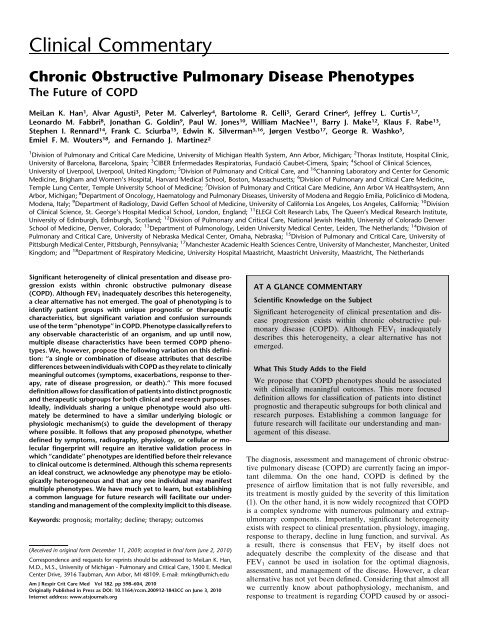
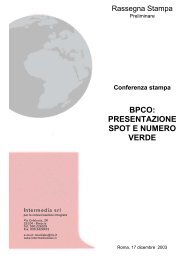
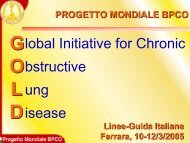
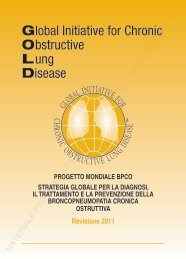
![Di Bari [NO].pdf - GOLD](https://img.yumpu.com/21544924/1/190x143/di-bari-nopdf-gold.jpg?quality=85)


